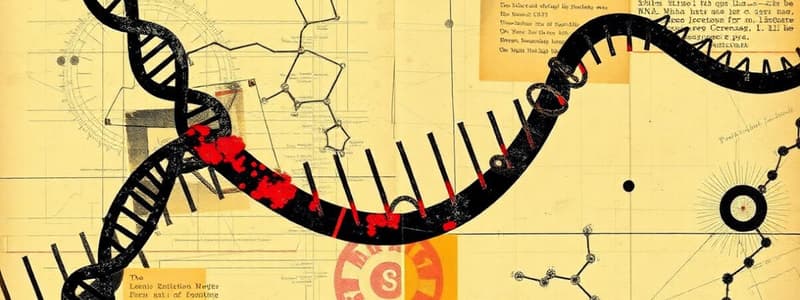Podcast
Questions and Answers
What primary factor distinguishes the sensitivity of RNA polymerase during DNA replication?
What primary factor distinguishes the sensitivity of RNA polymerase during DNA replication?
- Resistance to specific DNA inhibitors
- Sensitivity to temperature changes
- Dependency on magnesium ions
- Inhibition by rifampicin (correct)
How many primers does the leading strand require for synthesis?
How many primers does the leading strand require for synthesis?
- One primer synthesized at the ori site (correct)
- Two primers for continuous synthesis
- Multiple primers at different sites
- No primers are needed at all
What characterizes the synthesis of the lagging strand during DNA replication?
What characterizes the synthesis of the lagging strand during DNA replication?
- It does not require any primers
- It initiates with Okazaki fragments (correct)
- It uses a single primer for all fragments
- Synthesis occurs in a continuous manner
What is the nature of the primer used on the lagging strand?
What is the nature of the primer used on the lagging strand?
Which of the following statements about DNA replication in E. coli is true?
Which of the following statements about DNA replication in E. coli is true?
What is the characteristic of the leading strand during DNA replication?
What is the characteristic of the leading strand during DNA replication?
Which of the following statements accurately describes the lagging strand?
Which of the following statements accurately describes the lagging strand?
How does the initiation of leading-strand synthesis get affected by rifampicin in E. coli?
How does the initiation of leading-strand synthesis get affected by rifampicin in E. coli?
What is the role of primers in synthesizing the lagging strand?
What is the role of primers in synthesizing the lagging strand?
What distinguishes the leading strand from the lagging strand during DNA replication?
What distinguishes the leading strand from the lagging strand during DNA replication?
Flashcards are hidden until you start studying
Study Notes
Enzymatic Differences in DNA Replication
- Antibiotics can be used to differentiate between enzymes.
- Rifampicin inhibits RNA polymerase, but not primase.
- Leading strand initiation is sensitive to rifampicin, suggesting RNA polymerase is involved.
- Leading and lagging strand primer synthesis differs.
- The leading strand needs only one primer at the ori site.
- The lagging strand is synthesized in short fragments (Okazaki fragments) that each require a primer.
Enzymatic Differences in DNA Replication
- Rifampicin inhibits RNA polymerase, but not primase.
- Leading strand synthesis is sensitive to rifampicin because its initiation requires RNA polymerase.
- Leading strand only needs to be primed once at the ori site for continuous synthesis.
- Lagging strand synthesis occurs in fragments known as Okazaki fragments.
- Each Okazaki fragment requires a separate primer.
Studying That Suits You
Use AI to generate personalized quizzes and flashcards to suit your learning preferences.




